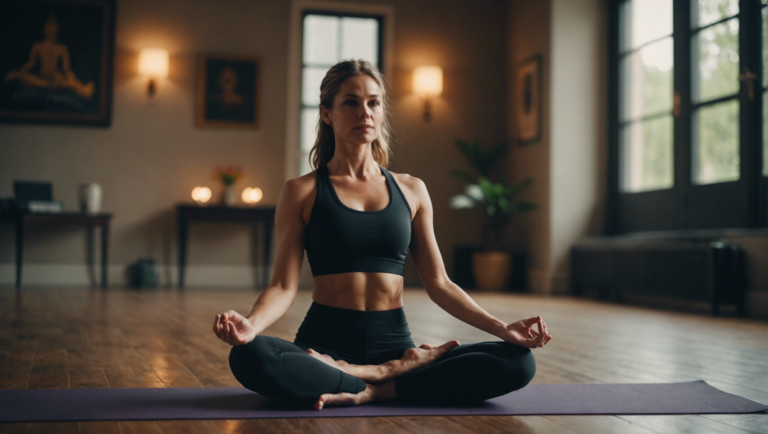Guidelines On How To Properly Execute A Forward Jump In Yoga
Benefits of Forward Jump in Yoga Practice
Yoga is a holistic practice that combines physical postures, breathing techniques, and meditation to promote overall health and well-being. Among the various yoga poses and sequences, the forward jump is a dynamic movement that offers a wide range of benefits for both the body and the mind. In this article, we will explore the advantages of incorporating forward jumps into your yoga practice.
Strengthening and Toning Muscles
One of the key benefits of performing forward jumps in yoga is the strengthening and toning of muscles. As you engage in this dynamic movement, you activate the muscles in your arms, shoulders, core, and legs. By repeating forward jumps regularly, you can build muscle strength and endurance, which is essential for maintaining overall physical fitness.
Improving Cardiovascular Health
Forward jumps in yoga are a great way to get your heart rate up and improve cardiovascular health. The dynamic nature of this movement increases blood circulation and oxygen flow throughout the body, helping to improve heart health and stamina. Including forward jumps in your yoga practice can contribute to better cardiovascular fitness over time.
Enhancing Flexibility and Mobility
The forward jump in yoga involves a combination of stretching and strength-building, which can help enhance flexibility and mobility. This movement targets various muscle groups and joints, such as the hamstrings, hips, and spine, promoting greater range of motion and improved flexibility. Regularly practicing forward jumps can help reduce stiffness and improve overall mobility.
Boosting Mental Focus and Concentration
In addition to the physical benefits, forward jumps in yoga also offer mental benefits. The dynamic nature of this movement requires focus, coordination, and concentration. By mindfully engaging in forward jumps, you can enhance your mental focus, calm the mind, and improve overall concentration. This can have a positive impact on mental clarity and cognitive function.
Stimulating Energy Flow
Forward jumps in yoga can help stimulate the flow of energy throughout the body. This movement activates the core muscles and promotes energy circulation, helping to release tension and revitalize the body. By incorporating forward jumps into your practice, you can create a sense of lightness and invigoration, promoting a balanced energy flow within the body.
Forward jumps into your yoga practice can offer a wide range of benefits for both the body and the mind. From strengthening muscles and improving cardiovascular health to enhancing flexibility and mental focus, this dynamic movement is a valuable addition to any yoga routine. Whether you are a beginner or an experienced yogi, exploring the benefits of forward jumps can help you deepen your practice and experience holistic well-being.
Proper Alignment and Body Mechanics for a Forward Jump
Understanding Proper Alignment and Body Mechanics for a Forward Jump in Yoga
Forward jumps into your yoga practice can offer numerous benefits, including increased strength, enhanced flexibility, and improved focus. However, to fully reap these advantages and prevent injuries, it is crucial to understand and implement proper alignment and body mechanics when executing a forward jump in yoga.
Maintaining Alignment in Forward Jumps
Proper alignment is crucial in yoga to ensure that the body is in the correct position to support the movements safely and effectively. When performing a forward jump, it is essential to start from a position of stability. Begin in a strong standing posture, engaging the core muscles to support the spine and pelvis.
As you prepare for the jump, focus on maintaining length in the spine and keeping the shoulders relaxed. Grounding through the feet, generate power from the legs to propel yourself forward. As you jump, aim to keep the knees aligned with the toes to prevent any unnecessary strain on the knee joints.
Engaging Core Muscles for Stability
Core engagement is key to maintaining stability and control during a forward jump in yoga. The core muscles, including the abdominals and lower back muscles, play a significant role in supporting the spine and pelvis. By engaging the core, you create a strong center from which to initiate and control the movement.
Focus on drawing the navel in towards the spine to activate the deep core muscles. This engagement not only supports the lower back but also helps to lift the legs higher during the jump. By strengthening the core and maintaining this stability throughout the movement, you can execute a smooth and controlled forward jump.
Mindful Landing and Weight Distribution
As you land from the forward jump, pay attention to the distribution of weight through the feet. Aim to land softly, bending the knees to absorb the impact and protect the joints. Keep the weight balanced between the heels and the balls of the feet to maintain stability.
Avoid locking the knees upon landing, as this can put excess pressure on the knee joints. Instead, focus on maintaining a slight bend in the knees to support the legs and allow for fluid movement. By landing mindfully and distributing the weight evenly, you can reduce the risk of injury and move smoothly into the next pose.
Forward jumps into your yoga practice can add a dynamic element to your routine and help to build strength and endurance. By focusing on proper alignment, engaging the core muscles, and landing mindfully, you can execute forward jumps safely and effectively. Remember to listen to your body, practice mindfully, and seek guidance from a qualified yoga instructor to enhance your practice further.
Breathing Techniques to Enhance Forward Jump in Yoga
When it comes to mastering the forward jump in yoga, proper breathing techniques play a crucial role in achieving fluidity, grace, and control in your movements. By syncing your breath with each motion, you not only enhance the physical aspect of the practice but also deepen your mind-body connection. In this article, we will explore effective breathing techniques that can help you execute a forward jump in yoga with precision and ease.
Importance of Proper Breathing
Proper breathing is the foundation of a successful yoga practice. In the context of executing a forward jump, controlled breathing enables you to engage your core muscles, maintain stability, and propel yourself forward with efficiency. By focusing on your breath, you can create internal heat, increase your energy levels, and improve your overall performance on the mat.
Ujjayi Breath
One of the most commonly used breathing techniques in yoga is Ujjayi breath, also known as the "ocean breath." This pranayama technique involves constricting the back of your throat slightly to create a gentle hissing sound as you breathe in and out through your nose. Practicing Ujjayi breath during your forward jump can help you stay present, calm your mind, and channel your energy towards achieving the desired movement.
Coordinating Breath with Movement
To execute a seamless forward jump in yoga, it is essential to coordinate your breath with the specific actions involved in the transition. As you prepare to jump forward, inhale deeply to draw in energy and lift your body off the ground. As you propel yourself forward, exhale forcefully to engage your core muscles and extend your reach. By synchronizing your breath with each phase of the jump, you can maintain balance, control, and fluidity in your movements.
Breath Awareness
Developing awareness of your breath during the forward jump not only enhances the physical execution but also cultivates mindfulness and presence on the mat. Pay attention to the quality of your breath – is it shallow or deep, smooth or erratic? By tuning into your breath patterns, you can adjust your technique, improve your lung capacity, and optimize your overall performance in yoga.
Mastering the forward jump in yoga requires a combination of strength, flexibility, and proper breathing techniques. By incorporating Ujjayi breath, coordinating your breath with movement, and cultivating breath awareness, you can enhance your practice, elevate your skills, and take your yoga journey to new heights. Remember, the breath is your constant companion on the mat – use it wisely, and let it guide you towards greater alignment, balance, and harmony in every pose you explore.
Common Mistakes to Avoid When Performing a Forward Jump
In the practice of yoga, the forward jump is a dynamic movement that requires strength, balance, and flexibility. While it can be a challenging yet rewarding posture to master, there are common mistakes that practitioners often make when performing a forward jump. By being aware of these pitfalls and implementing the proper techniques, you can enhance your practice and avoid potential injuries.
Lack of Proper Warm-Up
Before attempting a forward jump in yoga, it is crucial to ensure that your body is adequately warmed up. Without a proper warm-up, your muscles may not be prepared for the intensity of the jump, increasing the risk of strains or other injuries. dynamic stretches, such as sun salutations, can help loosen up your muscles and joints, making it easier to execute the forward jump with ease.
Incorrect Alignment
One of the most common mistakes in performing a forward jump is incorrect alignment. When executing the jump, it is essential to maintain proper alignment to prevent unnecessary strain on your joints and muscles. Ensure that your shoulders are stacked over your wrists, your core is engaged, and your hips are lifted to create a strong foundation for the jump.
Insufficient Core Engagement
Another common mistake is the lack of core engagement during a forward jump. Your core muscles play a significant role in stabilizing your body and generating power for the jump. By actively engaging your core, you can control the movement more effectively and transition smoothly from one posture to another. Focus on drawing your navel towards your spine and maintaining a strong core throughout the jump.
Poor Weight Distribution
Improper weight distribution can also hinder the execution of a forward jump. If you shift too much weight to your hands or lean too far forward, you may find it challenging to lift your hips and transition into the jump smoothly. To achieve the correct weight distribution, focus on evenly distributing your weight between your hands and feet, allowing for a more balanced and controlled movement.
Lack of Momentum
Momentum plays a crucial role in successfully performing a forward jump in yoga. Without adequate momentum, you may struggle to lift your hips off the ground and transition into the jump. To generate momentum, initiate the movement from your core and use a powerful exhalation to propel your body forward. By harnessing the power of momentum, you can make the forward jump feel more effortless and fluid.
Mastering the forward jump in yoga requires practice, patience, and attention to detail. By avoiding these common mistakes and focusing on proper alignment, core engagement, weight distribution, and momentum, you can enhance your practice and progress in your yoga journey. Remember to listen to your body, honor its limitations, and approach the forward jump with mindfulness and awareness. With dedication and perseverance, you can refine your technique and experience the many benefits of this challenging yet invigorating posture.
Progression Drills to Improve Forward Jumps in Yoga
Yoga is a practice that encompasses physical postures, breathwork, and meditation to promote overall health and well-being. Within the realm of yoga, forward jumps are dynamic movements that require strength, flexibility, and coordination. By incorporating progression drills into your yoga practice, you can enhance your forward jump technique and take your practice to the next level.
Understanding the Forward Jump in Yoga
The forward jump in yoga, also known as "hop through" or "jump through", is a challenging movement that involves transitioning from a seated position to a position with the legs extended forward. This fluid and controlled movement requires core strength, arm strength, hip flexibility, and balance.
Benefits of Improving Forward Jumps
Enhancing your forward jump technique in yoga can bring about various benefits to your practice. It can help develop overall body strength, particularly in the core and upper body. Additionally, mastering the forward jump can lead to smoother transitions between poses, improved focus and concentration, and a sense of accomplishment in your practice.
Progression Drills to Enhance Forward Jumps
-
Core Strengthening Exercises: Engaging in core strengthening exercises such as boat pose, plank pose, and leg lifts can help build the strength necessary to lift and control the legs during a forward jump.
-
Hip Opening Stretches: Incorporate hip opening stretches like pigeon pose, lizard pose, and butterfly pose into your practice to improve hip flexibility, which is crucial for achieving a smooth forward jump.
-
Arm Balances: Practicing arm balances such as crow pose and side crow pose can build arm strength and stability, both of which are essential for executing a controlled forward jump.
-
Jump Back Drills: Before attempting forward jumps, practice jumping back from a seated position to a plank pose. This drill can help you understand the mechanics of shifting your weight forward and lifting your hips.
-
Use of Props: Utilize props such as blocks or a bolster to provide support and assistance as you work on refining your forward jump technique. Props can help you maintain proper alignment and gradually build the strength and flexibility required for the movement.
Focus on Breath and Mindfulness
Incorporate mindfulness and breath awareness into your practice as you work on improving your forward jumps. Paying attention to your breath can help you stay focused and calm during the challenging moments of transitioning through the movement.
By incorporating these progression drills into your yoga practice, you can gradually enhance your forward jump technique and experience the numerous benefits it brings. Remember to approach the practice with patience, dedication, and a sense of curiosity to explore and push your boundaries in a safe and mindful manner.
Conclusion
Mastering the forward jump in yoga offers a myriad of benefits for both the mind and body. By incorporating this dynamic movement into your practice, you can enhance strength, flexibility, and balance while cultivating mindfulness and focus. Understanding the proper alignment and body mechanics is crucial to prevent injuries and maximize the effectiveness of the forward jump. Remember to engage your core, maintain a stable foundation, and utilize the momentum generated by your body to execute a seamless and controlled jump.
Breathing plays a fundamental role in enhancing the forward jump experience. By synchronizing your breath with movement, you can create a sense of flow and ease. Utilize deep inhalations to prepare for the jump and exhale mindfully as you propel yourself forward. Cultivating mindfulness in your breath can help you stay present and connected throughout the practice, deepening your mind-body awareness and fostering a sense of inner calm.
Avoiding common mistakes is essential in ensuring a safe and effective forward jump practice. Be mindful of overextending or collapsing the spine, rushing through the movement, or neglecting proper warm-up. Take the time to listen to your body, honor its limitations, and make adjustments as needed to maintain a sustainable practice. By cultivating self-awareness and attentiveness, you can minimize the risk of injuries and progress steadily in your forward jump journey.
To enhance your forward jump practice, incorporate progression drills that focus on building strength, flexibility, and coordination. Start with foundational exercises that target key muscle groups involved in the jump, such as the core, legs, and shoulders. Gradually increase the intensity and complexity of the drills as you gain more confidence and skill. Consistency and patience are key to mastering the forward jump, so stay committed to your practice and celebrate the progress you make along the way.
The guidelines outlined for mastering the forward jump in yoga can transform your practice and elevate your overall yoga experience. By paying attention to the benefits, alignment, breathing techniques, common mistakes to avoid, and progression drills, you can cultivate a more mindful, focused, and dynamic practice. Remember to approach each forward jump with intention, awareness, and joy, allowing yourself to explore the full potential of this empowering movement. Embrace the journey of self-discovery and growth that unfolds as you dive deeper into the practice of forward jumps in yoga.


